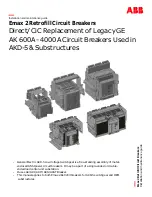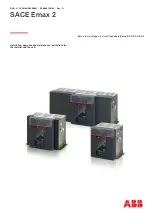
58
14-4 Breaker Compartment
Maintenance
General
A regular maintenance schedule should be es-
tablished to obtain the best service and reliabil-
ity from the breaker compartment. Plant operat-
ing and local conditions will dictate the fre-
quency of inspection required. For specific in-
formation regarding the maintenance of devices,
relays, meters, etc., refer to the separate instruc-
tion book furnished for each device. The breaker
testing device, which may be furnished as an
option, provides a convenient means for main-
taining the circuit breaker. Under normal oper-
ating conditions the protective relays do not
operate, therefore, it is important to check the
operation of these devices regularly.
A permanent record of all maintenance work
should be kept, the degree of detail depending
on the operating conditions. In any event, it will
be a valuable reference for subsequent mainte-
nance work and for station operation. It is rec-
ommended that the record include reports of
tests made, the condition of equipment and re-
pairs and adjustments that were made.
WARNING:
BEFORE ANY COVERS ARE
REMOVED OR AND DOORS ARE OPENED
WHICH PERMIT ACCESS TO THE PRIMARY
CIRCUITS, IT IS ESSENTIAL THAT THE CIR-
CUIT OR CIRCUITS BE DE-ENERGIZED AND
BREAKERS BE WITHDRAWN TO A DISCON-
NECTED POSITION, AND TAGGED.
IF WORK IS TO BE DONE ON REMOTE
EQUIPMENT CONNECTED TO A UNIT, THE
BREAKER FOR THAT UNIT SHOULD BE
PLACED IN THE DISCONNECTED POSITION
AND TAGGED. ALSO, REMOTE EQUIPMENT
SHOULD BE ISOLATED FROM ANY OTHER
POWER SOURCES CONNECTED TO IT.
The primary circuits of the equipment are insu-
lated in order to reduce the size of the equip-
ment. However, this insulation, except in one of
two instances, requires a certain amount of air
gap between phases and to ground to complete
the insulation integrity. Inserting any object in
this air space, when equipment is energized,
whether it be a tool or a part of the body, may
under certain conditions, in effect, short circuit
this gap and may cause a breakdown in the pri-
mary circuit to ground and cause serious dam-
age or injury or both.
6. Stationary Auxiliary Switch (MOC)
On units equipped with stationary auxiliary
switches, the clearance between the end of the
switch mechanism operating rod and the oper-
ating plunger on the circuit breaker should be 0
to 0.062" with the circuit breaker in the raised
and open position. Figures 10 and 40.
Any adjustment in this dimension must be
made on the auxiliary switch setting. Care
should be taken to prevent destroying
interchangability of the circuit breaker by ex-
cessive adjustment. Consult GE nearest sales
office.
7. Spring Discharge
When elevating or lowering the breaker, the
positive interlock lever roller on the breaker in-
teracts with the positive interlock cam in the
cell. Subsequently...The closing spring is dis-
charged and the breaker is trip-free. Figures 6
and 53.
CAUTION:
IF THE INTERLOCK DOES NOT
FUNCTION AS INDICATED ABOVE, DO NOT
MAKE ADJUSTMENTS. CONTACT YOUR
LOCAL GE REPRESENTATIVE FOR ADDI-
TIONAL INFORMATION.
8. Space Heaters
Space heaters are provided in all equipment in
order to keep the inside temperature several
degrees higher than that outside. By maintain-
ing a slight temperature differential, the heaters
help facilitate drying and prevent condensation
and the resulting corrosion and insulation dete-
rioration which might occur.
Before energizing the heaters, be sure the power
source is of the proper voltage, frequency, and
phase arrangement, and is connected in accor-
dance with the wiring diagrams furnished with
the equipment.
Heaters should be visually inspected several
times a year to assure they are operating prop-
erly. It is also recommended that the heaters be
energized at all times and that thermostatic con-
trol NOT be used.
PowerVac
®
5kV Vertical Lift
Chapter 14. Stationary Cubicle Subassembly





































